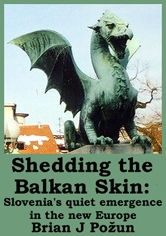This text is a whirlwind tour of Slovenia and an introduction to the Slovenes. It provides a brief history of the region and its people, with a particular focus on the twentieth century, especially the late 1980s and 1990s. The author shows how Slovenia went from the brink of all-out war to star student of the EU all in a few short years.
Basic data:
24,000 words, ten color pictures
100 pages in PDF, 83 A4 pages
seven main chapters
Chapters and excerpts:
I: Slovakia? Slavonia? Slovenia? Who Cares?
II: The Earliest History of the Slovenes (read excerpt)
III: The Slovene National Awakening
IV: Slovenia in Yugoslavia
V: Civil Society, Political
Pluralism and Independence (read excerpt)VI: Independence and Aftermath (read excerpt)
VII: Slovenia in the Twenty-first Century
Bibliography
Internet Links for Further Reading
* * * Buy and read the book now * * *
Excerpts...
The Slovene leadership had been pulling away from the federal leadership in Belgrade since the death of Tito, but in 1988, several incidents glaringly demonstrated that the more liberal attitudes of the Slovene establishment could not be reconciled with the conservative, centralist attitudes of the federal establishment in the context of Yugoslavia as it existed. A change was necessary,
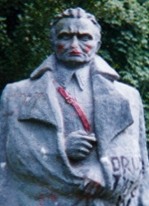 |
| Statue of Tito outside the former military barracks-turned-squat (Pekarna) in Maribor (Hema Žbogar) |
When it began publication, Mladina was the official newspaper of the Socialist Youth Organization of Slovenia (mladina is Slovene for "youth"). As the 1980s unfolded, Mladina became emboldened by the new liberal line of the Slovene establishment and increasingly took risks in its journalism. Together with Radio Študent, Mladina formed the foundation of independent journalism in Slovenia.
It got into trouble in early February 1988 with a series of articles about federal Defense Minister General Branko Mamula. One article claimed Yugoslavia was working with Sweden to sell arms to Libya; another exposed the fact that Mamula influenced the federal government to sell arms to Ethiopia in its civil war, calling him a "merchant of death"; a third article condemned Mamula for using soldiers of the federal army to build himself a villa on the Croatian coast. Never before had public criticism been leveled at the federal army, and its leaders were obviously not pleased.
The army began its campaign of vengeance on 18 February in its Narodna Armija newspaper. The newspaper called for an end to the "anti-Yugoslav campaign" raging in Slovenia. It charged Mladina with agitating for Slovene independence. Soon after, the federal prosecutor demanded the Slovene authorities try Mladina Editor-in-Chief Franci Zavrl for "libeling the honor of Yugoslavia and its army." Demonstrating their increasing distance from the federal government, the Slovene leadership refused to try Zavrl for libeling the nation but did accuse him of libel against Mamula.
The federal authorities felt increasingly threatened by the independent moves the Slovene leadership was making and decided to take a stand in the Mladina/Zavrl case. On 21 March 1988, the Federal Council for the Protection of Constitutional Order issued a statement accusing the Mladina articles of threatening constitutional order in Yugoslavia and demanding further investigation. The Federal Administration for State Security was enlisted to uncover the anti-Yugoslavia plot being planned in Slovenia. Days later, on 25 March, an advisory committee to the federal presidency concerned with national security issues, released a report on the counter-revolutionary actions occurring in Slovenia against Yugoslavia. On 29 March, the Slovene leadership refuted the charges at a secret meeting of the Central Committee.
Rumors rampaged through Ljubljana in April. Some feared the federal army was planning a junta in Slovenia to put an end to the perceived threat. Others were convinced that the federal government was planning a wave of political arrests throughout Slovenia. Mladina refused to bow to the pressure and in May tried to publish a speech that head of the Slovene Communist Party, Milan Kučan, gave at a secret meeting of the Slovene Central Committee, which they felt proved the federal army was planning some sort of military intervention. However, Mladina was forced to halt publication.
Things heated up at the end of May when Zavrl, Mladina journalists Janez Janša and David Tasić and Ivan Borštner, a Slovene member of the federal army, were arrested by the Slovene Intelligence Service and handed over to the military police. They were accused of possession of a classified military document that contained orders placing units in Slovenia on alert against Slovene separatism. Not only was the "Trial of the Four" closed to the public and journalists, but it was conducted in Serbo-Croatian-a clear violation of the Slovene constitution.
June 1988 brought public outrage at the "Trial of the Four" and at the ensuing conviction. The Committee for the Defense of Janez Janša was founded by journalists from several publications and Radio Študent and was joined by members of other civil society movements. On 22 June, the Committee organized a protest in Ljubljana that attracted some 40,000 people, making it the largest public demonstration in Slovenia since the end of World War II. Nevertheless, the trial ended in late of July with all four men being found guilty and convicted.
The Committee for the Defense of Janez Janša soon changed its name to the Committee for the Defense of Human Rights and quickly attained such strength and influence that it became the first civil society group that actually posed a legitimate threat to the government. Within weeks, it could lay claim to almost 100,000 members and had the support of more than 1000 other groups. It even attracted membership from outside of Slovenia, and branches were soon established in Belgrade and Zagreb. The fact that the Committee's demand for an investigation of the army was granted testifies to the Committee's power and importance.
Reformation and Counter-Reformation
For the Slovenes, life in the Austrian Empire under the Hapsburgs was similar to the experience of other non-German groups in the empire—most of the Slovene population was also among the peasantry, and the degree of assimilation into the German majority was great. The Reformation, having originated in Germany in 1517, began to penetrate Austria after 1520, raising new hope for the survival of the Slovene identity.
Among the Slovenes, the major figure of the Reformation was Primož Trubar (1508 to 1586). Trubar was a Slovene priest who converted to Lutheranism and went on to lead the Protestant movement in Slovenia. In 1542, he was appointed canon and preacher in Laibach (Ljubljana), the capital of Carniola, but was forced into hiding in Carinthia in 1547. Harnessing the Reformation's focus on the development and use of vernacular languages, Trubar established the first Slovene press at Urach, near Tubingen, Germany, where, in 1551, he published the first printed book in Slovene: Katekizm (Catechism).
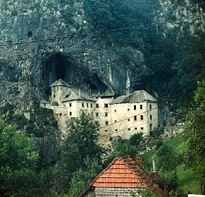 |
| 16th-century Predjamski Grad in Notranjska region (Hema Žbogar) |
Another significant figure of the Reformation among the Slovenes was Jurij Dalmatin (1547 to 1589). Dalmatin encountered the ideas of the Reformation at an early age, having attended a Protestant school in the Carniolan town of Krško, which was run by another important cultural figure, Adam Bohorič.
In 1572, Dalmatin moved to Laibach and began his life's work: the first complete Slovene translation of the Holy Bible. In the fall of 1578, Dalmatin and printer Janež Mandelec published the first part of the Scriptures, the Books of Moses, in an attempt to garner more financial support for the project.
The final translations of both the Old and New Testaments were finally printed in 1584 in Wittenberg, just 50 years after Luther published his German translation. Trubar was Dalmatin's mentor and had published a Slovene translation of the New Testament in 1582, although there are great disparities between the two works. The work of Trubar and Dalmatin, along with Adam Bohorič's grammar published in 1584, form the foundation of the modern Slovene language.
The Counter-Reformation, launched by the Catholic Church in 1545, did not reach its peak in the Slovene lands until 1579. Fortunately for the burgeoning Slovene language, the Counter-Reformation allowed the use of vernacular languages in both sermons and hymns. The works of the reformers were used by the counter-reformers as well, and with Catholic revisions, even they valued Dalmatin's Holy Bible.
The major feature of the Counter-Reformation in the Slovene lands was the Jesuits' founding of a university in Laibach in 1597, which would eventually grow into today's University of Ljubljana. Ultimately, the Counter-Reformation was successful in the Slovene lands: when, in 1628, Emperor Ferdinand II offered Protestants a choice between re-conversion and exile, most chose re-conversion.
In late March 1994, Prime Minister Drnovšek fired Minister of Defense Janez Janša under the pretext of a scandal involving alleged abuse of civilians by military police. Janša's popularity with the electorate was improving, while at the same time his popularity with high-level government figures, including President Kučan, was non-existent.
Less than two months later, factions within the Italian government launched a diplomatic assault on Slovenia, claiming that a
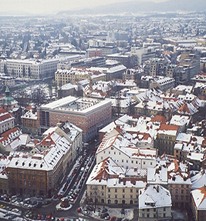 |
| View of Ljubljana from atop the castle tower (Brian J Požun) |
The Italians also demanded revisions to the 1975 Treaty of Osimo, whereby Italy and Yugoslavia ceased claims on each other's territory. Peterle succeeded in convincing the Italian government that Slovenia was a legal successor to Yugoslavia and considered itself bound by any international agreements that the former state had ratified.
Peterle, however, resigned from the Ministry of Foreign Affairs just months later, in September, in protest against the main faction in the governing coalition, the LDS. The speaker of the House had resigned, and the LDS had gained approval for its candidate to the post by a very narrow majority. Peterle felt this move gave the LDS too much power in the government; in addition to resigning, he attempted to lead his party, the SKD, out of the coalition, but it refused to follow him.
Peterle stayed on as foreign minister for one month after his resignation at the request of Prime Minister Drnovšek in order to complete negotiations with Italy concerning Slovenia's bid for EU membership. Peterle and his Italian counterpart did reach a sort of agreement, but when the document came up in the Assembly, it was not approved due to reservations on the part of the LDS. The move caused serious problems in bilateral relations with Italy that were not corrected for more than a year.
Local elections were conducted in December in 147 municipalities. The positions of Mayor and members of Local Councils were up for grabs, and the SKD ended up trouncing the LDS.
On 26 January 1995, Zoran Thaler was appointed to replace Peterle as Foreign Minister. Thaler immediately set out trying to repair the damage done in relations with Italy, Croatia and European bodies. In the case of Italy, he managed an early success by promising that
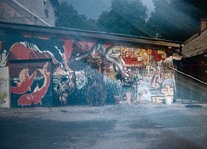 |
| Wall mural at the former military barracks-turned squat in Maribor (Hema Žbogar) |
Formal negotiations with the EU concerning the association agreement were able to begin on 15 March, and a partnership agreement was signed on 10 June 1996. Prime Minister Drnovšek officially announced that Slovenia was submitting an application for full membership at the signing of the agreement. Further gains in foreign relations were made in November, when Slovenia joined the Central European Free Trade Agreement (CEFTA). The membership at that time was composed of the Czech Republic, Hungary, Poland and Slovakia.
The political situation had stabilized somewhat throughout 1994 and 1995, but as the time drew near for parliamentary elections scheduled for autumn 1996, complications arose...
To read the full text of
Shedding the Balkan Skin,
go to the CER eBookshop and
purchase the ebook.


